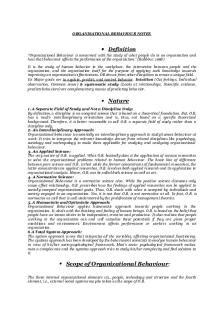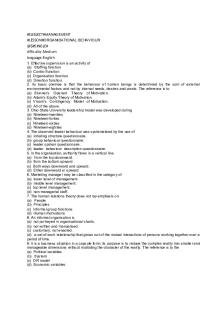Organisational Behaviour - Barclays PDF

| Title | Organisational Behaviour - Barclays |
|---|---|
| Course | Theory and Practice of Organisational Behaviour |
| Institution | Cardiff University |
| Pages | 3 |
| File Size | 129.7 KB |
| File Type | |
| Total Downloads | 14 |
| Total Views | 153 |
Summary
Description of a company, how it works and the management - Barclays Bank...
Description
Organisational Behaviour
Q2)
BST512
BARCLAYS BANK & WHITE COLLAR EMPLOYEE SATISFACTION
For the last five years, I have been visiting Barclays Bank for daily banking transactions but yesterday I paid a visit for a completely different reason, which made me realise, in conjunction with my background knowledge in organizational behaviour, why the bank in question is performing so well all these years and why all of its white collar employees (Hu, Kaplan and Dalal, 2010) are so happy. I personally believe that frontline employees reflect a mirror image of a company and their level of satisfaction depends on the managerial mix (Adizes, 2004) and culture within the company. Apart from that, credit rating companies like Moody’s can value the performance of a company and apply a risk rating, just by analysing employee’s performance (Christiansen, 2004)." When I got into the bank, a lady welcomed me and after explaining her the problem that I invented for observation purposes, she told me to take a seat until her colleague took me upstairs to a personal banker. While I was waiting patiently, I saw great cooperation between two employees who had to deal with an angry customer whose debit card had been kept by an automatic teller machine (ATM). I heard that the first employee had been working in the bank for less than four days and she faced that problem for the first time but instantly her colleague, sitting at the front desk came and helped with the situation without making her feeling uncomfortable for having no answer to that problem. On the one hand, lack of efficient job training can lead to employee dissatisfaction. This is because people are very concerned about their productivity and customer satisfaction within a business environment (Truitt, 2011). On the other hand, efficient team spirit is a significant aspect which contributes to raising the levels of employee satisfaction and labour productivity (Ezzamel & Willmott, 1997). In the background, I saw only one employee working as a bank cashier while the rest were self service automated machines. These machines have replaced human cashiers, so to minimize the human error and increase the speed of transactions. According to Herzbergs Two-Factor theory of work motivation (Farr, 1977), minimizing the ‘Motivator’ of responsibility at work can have negative psychological effects on employees and make them feel not satisfied of their output." A couple of minutes later, someone called my name and while we were walking upstairs I heard the bank’s manager congratulating a banker for his outstanding performance in a situation where using his authority and judgement, declined the approval of a loan to a fraudulent customer whose loan the system had previously approved. It is more than clear that this recognition on the part of his manager, satisfied him because people in a working environment are more satisfied when someone tells them that they have performed well at a task rather telling them the opposite (Locke, Cartledge, & Knerr, 1970; Locke & Latham, 1990)." Before talking about my issue I asked my personal banker what he liked most working with Barclays Bank and he told me the job rotation and the organizational culture but he did not
Organisational Behaviour
BST512
mention anything about salary. Herzberg in contrast to Tailor, another remarkable business motivation theorist (Ferraro, 2016), believed that workers were motivated by anything other than money. His Two-Factor theory was more convincing about the importance of non-financial factors where he stated salary as ‘Hygiene factor’ and insisted that financial rewards should exist but they are not enough on their own to make employees feel satisfied, they are just no longer dissatisfied (Farr, 1977). So, the best combination for employee performance maximization is high hygiene and high motivation according to Herzberg. Job rotation is proven to satisfy employees working in the banking industry (Mohammadi, Ramezani, 2017 and Jeon, 2013) whereas in other areas like the medical sector, studies have shown opposite results (Chen, Wu, Chang, and Lin, 2013)." Culture and leadership are two concepts, linked to each other and both are very important for the maximization of employee satisfaction and performance within a company (Ogbonna and Harris, 2000). According to Vroom, employee satisfaction determines the level of their performance in an organization (Vroom, 1995). From my point of view I believe that employee satisfaction can have positive effects in the long term performance of the organization and success but it is not the driving force for performance increment among all kinds of companies. By long term effects I mean that a satisfied employee can guarantee a satisfied customer and a satisfied customer can result in an increment in company’s profit. To support this belief I will give two examples of different companies where job satisfaction are not always related. On the one hand, bad labour rights and working conditions is something very common among many Chinese factories (Xiaojun, 2017) . People working in these factories don’t have any other option but to be productive despite the fact that they are dissatisfied. On the contrary, people who work in the frontline of a company like salespeople, job satisfaction can increase their work performance because satisfaction means positive psychology, something very important when dealing with customers and can have an instant effect on them." Last, there are many disagreements whether job satisfaction and increment of work performance are related. Extraordinary work performance can lead to job satisfaction but the opposite is still debatable. Job performance is related with employee’s ability and motivation whereas job satisfaction is a result of social, environmental and cultural factors. However, employee satisfaction doesn’t always mean high employee performance because the previous example with Chinese factories showed that highly productive employees are not the most satisfied ones. The management of a company plays significant role in increasing employee’s job satisfaction. Management is responsible to maintain, review and create a positive environment and ensure that employees have the necessary tools and supplies to successfully achieve their job. The key success for managers in order to achieve the best managerial mix for their organization’s success, is to ensure long term employee satisfaction and set goals that can be reached from them." To sum up, I believe that the managerial position is the most difficult one within a company because you are responsible for finding the best combination for stakeholders and shareholders satisfaction. Despite all these motivation theories, each manager should try to deeply understand
Organisational Behaviour
BST512
the environment and the culture of a company before applying them and consider the balance or imbalance that exists between employee’s inputs and outputs (Adams, 1976)."
References Adams, J. and Freedman, S. (1976). Equity Theory Revisited: Comments and Annotated Bibliography. Advances in Experimental Social Psychology, pp.43-90. Adizes, I. (2004). The ideal executive. 1st ed. Santa Barbara, Calif.: Adizes Institute, pp.121-124. Ali-Mohammadi, F. and Ramezani, M. (2017). Evaluate the effectiveness of job rotation system and its impact on employees' readiness for job rotation: Case study of: Maskan bank branches in the city of Tabriz. International Review, (1-2), pp.27-35. Chen, S., Wu, W., Chang, C. and Lin, C. (2013). Job rotation and internal marketing for increased job satisfaction and organisational commitment in hospital nursing staff. Journal of Nursing Management, 23(3), pp.297-306. Christiansen, C., Dyer, D., Harbord, P., Joubert, P., Markou, E., Murray, C., InNg, H., Procter, K., Sweeting, P. and Tay, A. (2004). An Analysis and Critique of the Methods Used by Rating Agencies. In: Joint Faculty and Institute of Actuaries 2004 Finance & Investment Conference. [online] London: FIB Credit Working Party, pp.24-29. Available at: https://www.actuaries.org.uk/documents/analysis-and-critique-methods-used-rating-agencies [Accessed 8 Dec. 2018]. FARR, R. (1977). On the nature of attributional artifacts in qualitative research: Herzberg's two-factor theory of work motivation. Journal of Occupational Psychology, [online] 50(1), pp.3-14. Ferraro, S. (2016). Frederick Taylor’s other Principles. International Journal of Business and Social Science, 7(11), pp. 24-26. Fisher, C. (2003). Why do lay people believe that satisfaction and performance are correlated? possible sources of a commonsense theory. Journal of Organizational Behavior, 24(6), pp.753-777. Hu, X., Kaplan, S. and Dalal, R. (2010). An examination of blue- versus white-collar workers’ conceptualizations of job satisfaction facets. Journal of Vocational Behavior, 76(2), pp.317-325. Jeon, I. and Jeong, B. (2013). Effect of Job Rotation on Job Satisfaction, Occupational Safety and Health. Journal of the Ergonomics Society of Korea, 32(5), pp.429-435. Ogbonna, E. and Harris, L. (2000). Leadership style, organizational culture and performance: empirical evidence from UK companies. The International Journal of Human Resource Management, 11(4), pp.766-788. Truitt, D. (2011). The Effect of Training and Development on Employee Attitude as it Relates to Training and Work Proficiency. SAGE Open, 1(3), p.215824401143333. Vroom, V. (1995). Work and motivation. San Francisco: Jossey-Bass Publishers, p.91. Xiaojun, F. (2017). Manufacturing Conflict: The Experience of a World Factory in a Changing China. Modern China, 43(6), pp.590-619....
Similar Free PDFs

Organisational behaviour
- 1 Pages

Organisational Behaviour
- 26 Pages

Organisational Behaviour Notes
- 9 Pages

Lec+2-+Organisational+Behaviour
- 22 Pages

Organisational Behaviour MCQ
- 121 Pages

BFGym - Organisational Behaviour
- 9 Pages
Popular Institutions
- Tinajero National High School - Annex
- Politeknik Caltex Riau
- Yokohama City University
- SGT University
- University of Al-Qadisiyah
- Divine Word College of Vigan
- Techniek College Rotterdam
- Universidade de Santiago
- Universiti Teknologi MARA Cawangan Johor Kampus Pasir Gudang
- Poltekkes Kemenkes Yogyakarta
- Baguio City National High School
- Colegio san marcos
- preparatoria uno
- Centro de Bachillerato Tecnológico Industrial y de Servicios No. 107
- Dalian Maritime University
- Quang Trung Secondary School
- Colegio Tecnológico en Informática
- Corporación Regional de Educación Superior
- Grupo CEDVA
- Dar Al Uloom University
- Centro de Estudios Preuniversitarios de la Universidad Nacional de Ingeniería
- 上智大学
- Aakash International School, Nuna Majara
- San Felipe Neri Catholic School
- Kang Chiao International School - New Taipei City
- Misamis Occidental National High School
- Institución Educativa Escuela Normal Juan Ladrilleros
- Kolehiyo ng Pantukan
- Batanes State College
- Instituto Continental
- Sekolah Menengah Kejuruan Kesehatan Kaltara (Tarakan)
- Colegio de La Inmaculada Concepcion - Cebu









